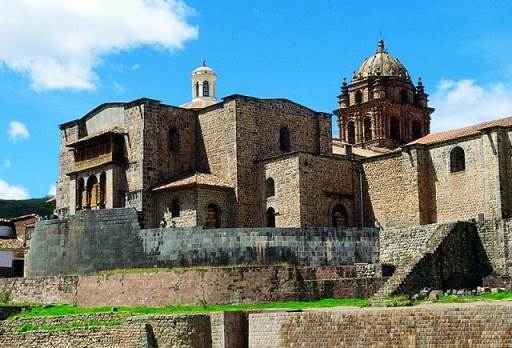What is it?
The name Koricancha – or Coricancha- comes from the quechuas voice Quri kancha, “golden temple”, and it is the place where in present times the Convent of Santo Domingo is located in the city of Cusco.
Why is it important?
This temple is one of the most recognized, not to say the most recognized one; therefore is a matter of a sacred place in which it was yielded worship to the Inti (God Sun), the maximum deity of the Empire of the Inca. It is for this reason that previously, when people wanted to enter the temple, people had to fast, be barefoot and with some lump or weight in their backs; in this manner they would be expressing humility, an indispensable requirement requested by the oldest priest, Wilaq Umu.
It is said that the facade of this temple was made of an elaborate wall of the finest stonework (or portion of stone work), that was decorated with a greatly finished band of gold, whose height was like the height of a hand palm, and its ceiling was made of a straw that had been delicately cut. Several of its structures were modified, initially with the conquest, the Spaniards built on the temple what today is known as the Convent of Holy Sunday and subsequently, after the earthquake of 1950.

How is it?
The Koricancha is made up by a series of constructions that are centered in the court, species of patio, around the one that was built. Among these constructions we have:
- Precincts: One of these was found next to Intipampa, containing thus one of the main buildings in it was yield worship to the Sun and to other Inca Gods. In the second, worship was yield to Punchao, representation of the Sun made of pure gold, that measure the approximate stature of a boy of around ten years of age. Punchao, remained in this precinct during the day, while by nights it was carried to the plaza to be venerated. The princesses accompanied this idol during the nights, and then was returned to its precinct during the morning.
- Chambers: the name of chambers was utilized by Garcilaso , and these were utilized for meetings of the religious hierarchy, where the oldest priest was also received, or Wilaq Umu. In the fund of these remain still the remainders of what was the greater chambers.
- Garden: was used to be watered by hand by the acllas, and adorned three times a year with cobs of corn and fruits placed by the princesses in the times of seeding, cropping or when the youths were made warriors at the party of Warachikuy (festival in which the youths were made up in groups and thus they showed its capacities for the defense of the empire; this festival marked the passing of adolescence to maturity).
- The temple for the Gods: as we have already seen above, in the Koricancha not only was venerated the God Sun, but also other Gods, like the Moon and Venus. According to the Inca Garcilaso de la Vega, writer and historian hispanicperuvian, in the precinct found in the northwest part of the temple, worship was yielded to the Moon; in the next one, to Venus, pleiades and other constellations.
There was a plate of gold in the facade of the temple, that is currently partly destroyed, as a result of the colonial times.
How to arrive?
To arrive at the temple of Koricancha you can arrive from the Main Square in Cusco (Plaza de Armas de Cusco), continuing to the street Loreto and turning toward the left along the street Maruri. The exact address is the intersection of the avenue El Sol and Santo Domingo. See map .
This temple is a great sample of the fervor and the religious faith that characterizes many cultures, in this case, the Inca culture.



